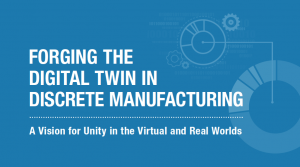This is Part 7 of our 12-part blog series based on the LNS Research eBook “Forging the Digital Twin in Discrete Manufacturing: A Vision for Unity In the Virtual and Real Worlds”.
Previously in Part 6 we looked at the opportunities presented by Digital Twins in manufacturing. Now let’s explore how Digital Twin technology can simulate product use.
Simulating Product Use
Over the last few years, the market – spanning software vendors, market researchers, and even end-user communities – has spent much time on and written volumes about simulation. Companies involved in design and manufacturing systems have invested heavily in ever increasing fields of simulation. With access to huge computing clusters on the Cloud and multi-physics simulation systems, creating a fully dynamic Digital Twin is now a reality.
Simulation is essential for manufacturers considering a Digital Twin software purchase. The capabilities might be available from a PLM software vendor or even specialist simulation companies that focus on specific solutions such as aerodynamics, heat, people, complete subsystems such as robots, or whole machines like bottling equipment.
As manufacturers undertake industrial transformation, the holy grail is to improve business and manufacturing performance through Big Data analytics. Simulation can be a significant source (and consumer) of Big Data for manufacturing process improvement, and for the product itself.
Simulation comes in many forms, from simulating single parameters (such as a temperature gradient in a process) to multi-physics simulation where the data used covers various first principle laws. Simulation scenarios might include thermodynamics and aerodynamics working simultaneously in a single product. The value of a Digital Twin increases as we move both physical and data-driven models closer to a faithful representation of use in the real world. For each case, the depth and fidelity of the simulation will vary across parts of the system. Today, manufacturers can build a complete virtual model of a complex product like a car, washing machine or even aircraft — the Digital Twin means being able to model all aspects of its behavior.
EXALEAD Commentary:
With Dassault Systèmes’ 3DEXPERIENCE twin, manufacturers can make virtual products available to the market for experimentation and testing in realistic conditions before engaging in any real production. Capturing the consumer experience while running a shortcut of the manufacturing process enables significant cost savings while reducing the company’s footprint. Companies can innovate at precisely the rate of market demand, delivering customized products and experiences to meet customer needs.
The ability to simulate the physical and functional behavior of the virtual asset makes this collaboration possible by allowing the user to project his experience with the future product in realistic situations.
Dassault Systèmes’ 3DEXPERIENCE twin model-based systems engineering capabilities empower manufacturers to perform complex scenarios and ask unlimited “What-if” questions on components, systems, system of systems, and even up to cyber-systems, accelerating innovation.
In the next blog installment, we will explore simulating the manufacturing process with Digital Twins.
Part 1: What is a 3DEXPERIENCE Twin?
Part 2: Digital Twins and Manufacturing: Today’s Possibilities
Part 3: Who is Using Digital Twin Technology?
Part 4: Growth Expectations for Digital Twins in Manufacturing
Part 5: Digital Twin Use Cases in Manufacturing
Part 6: Exploring Digital Twin Opportunities in Manufacturing
Part 7: Simulating Product Use with Digital Twins in Manufacturing
Part 8: Simulating the Manufacturing Process with Digital Twins
Part 9: Software in Digital Twin
Part 10: Real Data Versus Virtual Data
Part 11: Digital Twin: Pragmatic Considerations
Part 12: Recommendations for Getting Started with Digital Twin

Read LNS eBook on Forging the Digital Twin in Discrete Manufacturing
Join our User Communities to stay on top of the latest industry news, ask questions and collaborate with peers:
- EXALEAD Sourcing & Standardization Intelligence User Community
- 3DEXPERIENCE Marketplace | PartSupply User Community
- NETVIBES Public Community

